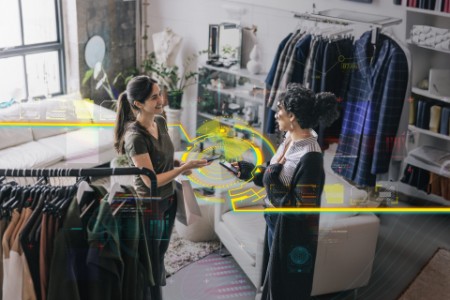
Chapter 1
Fast-tracking generative AI in retail and CPG: scaling pilots
The potential benefits of integrating GenAI across the wider business ecosystem are mounting.
The EY Strategy Edge platform identified over 277 AI-related deals in the consumer industry market between 2020 and 2023, amounting to investments of over US$8b. Although GenAI explicitly accounts for only 5% of these deals, don’t be fooled into thinking it’s not significant. Much of the excitement around GenAI has taken place in the last year. Its ability to improve and combine with other technologies means that it has progressed rapidly through its own hype cycle and become a key consideration in the consumer market.
We are already seeing use cases cascade throughout consumer businesses, ranging from faster and cheaper marketing to highly automated contracting processes. A breakdown of the identified consumer AI-related M&A deals shows them spanning the entire enterprise, with one-third related to sourcing and procurement at one end of the value chain, and one-fifth helping drive sales and last-mile solutions at the other end. While current perceptions of GenAI typically see it as a functional toolset which can be leveraged to provide solutions to a range of individual business needs, the real power will be realized when organizations start to view it as an enterprise enabler for their own business transformation. This integration will help it deliver innovative experiences for customers and employees that can drive value across multiple functions at once.
GenAI in practice: how EY teams are working with consumer-facing companies
Here are four very different examples of how EY teams are helping CPG companies and retailers use GenAI.
As GenAI becomes implemented across different functions, the potential to integrate it into the wider business ecosystem is becoming more prominent. This will be driven, in part, by the open source and interoperable nature of many applications. GenAI can be seen as a technological Swiss Army Knife which can be adapted and used for many different purposes. The solutions it provides may be things that other technologies could deliver, but perhaps not as quickly, easily or cost effectively. For example, if GenAI can be used to make it easier for different coding systems to work together within the same business, then it can also be applied to break through technology silos between ecosystem partners to improve the accuracy and efficiency of processes like procurement, supply chain transparency and quality standards.
Consider this — you don’t need a “one size fits all” generative AI strategy
Many business intelligence providers have already added LLM layers to speed up and customize the information that they can provide for consumer companies. While some retail and consumer goods companies are partnering with them to improve their strategic insights functions, others are seeking to build or develop LLM platforms of their own to deliver control and customization.
There is no need to choose between these approaches; both can bring different benefits. Integrating and training an existing LLM with consumer databases can provide quick wins in speeding up processes and applications, but this can go hand in hand with developing a bespoke model trained on specialist data to drive advantage in capabilities specific to your business. The former helps you move quickly with the technology, while the latter delivers targeted results in priority areas.
Where to act now
Explore strategic partnerships. Brands and retailers may have to build up new technical capabilities very quickly, but technology vendors and platforms will already have plug-and-play solutions that can be used for quick and easy use-cases, from improving customer journeys to simplifying contract processes. Working with these partners will enable companies to leverage and deploy GenAI solutions while they build and develop their in-house capabilities.
What to decide later
Identify areas of the business where specialist or pre-trained models will bring the most benefit and set a roadmap to build the internal skills or secure external partners required to deliver them. Consider developing capabilities and engaging a variety of vendors that can provide replicable and scalable solutions for distinct areas of business need that third-party applications may not be relevant for without significant customization.
GenAI and synthetic media are redefining content creation by driving down associated costs as well as increasing speed to market exponentially, but they must go hand in hand with governance.

Chapter 2
GenAI is a risk-reward paradox for CPG companies and retailers
Leaders agree on the transformative power of GenAI, but not on how to create value without risk.
For consumer leaders, GenAI applications have clear and tangible opportunities. Unlike the metaverse, which currently charts an elusive path to an uncertain future, GenAI provides quick and easy use cases for businesses to build capability around. According to the EY CEO Outlook Pulse, 40% of consumer leaders already think they are successfully leveraging GenAI, with more than one in five (22%) reporting that they are already seeing it have a significant impact on how their business functions operate.
With this optimism comes an imperative for acting quickly, and 70% of consumer leaders agree that they must act on GenAI now to avoid giving competitors a strategic advantage. Company announcements and media coverage of consumer initiatives confirm this perspective, with daily reports of new GenAI-powered tools in the consumer industry market, from AI-powered shopping assistants and new customer service bots to more responsive demand-planning applications and workforce tools.
Source: EY
But the buzz surrounding GenAI is also creating a lot of noise for leaders to consider, with only 8% of consumer leaders seeing themselves as adopting leading GenAI practices and two-thirds (67%) agreeing that uncertainty around GenAI makes it challenging to develop and implement an AI strategy.
As the hype begins to recede, some leaders are preparing themselves for a longer journey, with 37% believing it will be three to five years before GenAI significantly impacts their business and operating models. Part of this may be driven by the economic realities of today, with 60% of consumer CEOs seeing that investment in GenAI is reallocating capital away from other budgets. This opportunity cost may prove costly if financial rewards aren’t forthcoming quickly.
Another EY survey, Reimagining Industry Futures, which focuses on information and communication technology (ICT) respondents, found that of over 250 consumer company ICT executives surveyed, only 35% were actively investing in GenAI (although a further 33% do plan to invest this year) and, while 68% of consumer companies are building proofs of concept around applications for GenAI, none are currently deploying them across the enterprise in business-critical processes.
This points to a potentially paralyzing paradox for consumer companies to consider. There is widespread consensus among leaders about the transformative power of GenAI but a high degree of uncertainty, particularly within their businesses, about where and how it can best be deployed to create value (according to 36% of consumer company respondents in the Reimagined Industry Futures survey) and about the governance required to manage the technology (35%).
Consumer-facing companies are particularly exposed to the risks associated with using GenAI. Brands, which can take decades to build a trusted relationship with their consumers, have been rightly cautious in adopting technologies built on open-source or open-access platforms using unfiltered datasets. This caution has been exacerbated by high-profile examples of potential biases and “hallucinations.” Added to that is the risk of copyright infringements from the content LLMs could generate and intellectual property leakage that could result from unsolicited use of a resource that is globally accessible to different communities. With regulators also taking steps to impose stricter controls on AI usage, notably through the European Union AI Act (pdf) , the risk of legal repercussions has tempered the enthusiasm of larger brands and retailers, with some closing off employee access to publicly available GenAI platforms.
Consider this — GenAI governance and its implementation must go hand in hand
Building a clear and consistent governance is crucial to the successful management of any emerging technology, especially given some very prominent concerns being raised about GenAI in the market. But the business benefits GenAI can bring, and the ever-expanding array of use cases presenting themselves, are impossible to ignore.
To resolve this paradox, consumer companies should consider implementation and governance as concurrent, interconnected strategies. Testing and learning will help accelerate best practices to ensure that a governance structure around data and AI will be both relevant and useful in shaping your AI strategy. A governance framework built on some basic common principles can be adapted and applied more easily when there are live use cases and deployments to test it against. Where there are fears over risk of brand exposure, focusing solutions on distinct processes and areas of the business can enable controls to be put in place before scaling them more broadly. A key part of this lies in having consistent visibility over where and how GenAI tools might be deployed and how they might ultimately be used to benefit different areas of the business.
Where to act now
Review and iterate your AI strategy … continuously. The technology is moving fast, and larger consumer enterprises, in particular, need to understand where it is being deployed in pockets of their business so that they can both impose the relevant controls and explore how smaller pilots might bring scaled benefits further down the line (Read the Embedding AI case study in “GenAI in practice” in chapter 1 above.) Establishing, then continually evolving, a governance structure based on common principles will enable consumer companies to test different applications with consistency to minimize their exposure to risk.
What to decide later
Establish a centralized capability that can have oversight of how AI is being deployed across the enterprise to ensure opportunities for scaling initiatives and minimize downsides. Use scenario planning to assess the risk and reward of AI deployments based on expected regulatory changes and fast-moving technological change.

Chapter 3
GenAI will drive new consumer behaviors disrupting relationships
As consumers ask GenAI for recommendations, brands and retailers must rethink customer engagement.
It is easy to focus on the business implications of GenAI, but the impact that it has on consumer behavior and how consumers engage with businesses could ultimately be far more profound. Ignoring this would be a mistake, but it has been made before. The genesis of the internet was grounded in its academic potential, but it has become ubiquitous in defining an age of digital consumption.
More recently consumers have become dependent on mobile phones, even though they rarely use them for their original purpose, to make phone calls. By using LLMs to help machines understand people better, GenAI is redefining the relationship between humans and technology. In the past, people have had to understand machines to make the best use of them, but increasingly machines are building an understanding of people that will make interaction between them natural and intuitive.
For the last seven years, EY has been exploring how disruptive technologies such as AI could ultimately shape new consumer behaviors. By working with futurists, leaders and industry experts, the FutureConsumer.Now program established a range of future scenarios, and in almost all of them consumers were highly dependent on AI to curate and manage large aspects of their lives. Consumers will not necessarily notice these changes; instead, digital technologies are likely to become ubiquitous and invisible, embedded into applications that guide consumer behaviors and support frictionless engagement with retailers and brands.
The rapid emergence of GenAI could be accelerating progress towards these future scenarios both in terms of how GenAI can shape and curate choices and in terms of how it can be leveraged to deepen consumer engagement. The first use cases to emerge in the consumer industry market for GenAI were sharply focused on engagement and personalization. These included consumer co-creation in brand campaigns, personalized messaging and media, digital shopping and recipe recommendations, and AI-augmented or entirely automated customer services. As the scope of applications continues to extend into the wider business ecosystem, the focus on how AI can redefine the relationship between the consumer and the companies that serve them must remain top of mind.
As part of the EY Future Consumer Index, we explored this by establishing what consumers themselves thought about how emerging technologies would impact their lives. Today consumers remain divided between their trust, and reliance, on technologies like GenAI.
Although over 70% of consumers are already engaging with AI as part of their daily lives, 61% feel that governments need to do more to regulate its use. Two-thirds (68%) of consumers expect that it will make their jobs easier, but 35% are worried that it will replace their jobs altogether. Furthermore, 42% of consumers expect technologies such as GenAI will mean that the working week shortens to four days before the end of the decade. If this comes to pass, even as an indirect impact of GenAI, it will have a significant impact on how consumers shop and what they buy.
Sentiment among consumers can be divided into distinct groups. Almost one-third (31%) could be considered enthusiasts based on their responses. For example, 89% of enthusiasts are willing to trust AI-powered chatbots. But over one-fifth (21%) could be considered as skeptics, with 84% of this group not willing to trust AI-powered chatbots.
Source: EY Future Consumer Index
Consider this — your future consumer could be an algorithm
The bifurcation in attitudes today has longer-term implications. On the one hand, a significant proportion of consumers are likely to embrace, or passively adopt, GenAI solutions by delegating decisions to AI-powered tools and allowing AI to curate media content, products and services for them. Many may hand over management of their financial or social affairs to AI, trusting that it will act in their best interests and optimize their lives.
As this evolves, algorithms will form an invisible layer between consumers and the brands or retailers that serve them. Today, using GenAI to deliver tailored media and personalized messaging may create a wave of AI-generated content that threatens to overwhelm consumers.
Tomorrow, reaching the consumer may depend on providing something compelling enough to get past the algorithms that curate for them. Basic purchase decisions will be governed by AI, and consumers will engage with brands through channels curated by their own AI tools. Business models such as D2C will evolve into AI2AI as brands develop GenAI tools tailored to AI-powered applications that the consumer trusts as much as for the end consumer.
To succeed here, high levels of personalization on product, price and service will become table stakes, with customer segmentation delivering insights at the level of individual consumers or households rather than broader demographic groupings.
At the other end of the spectrum may be a large minority of consumers who actively avoid using AI to curate their lives. These consumers would seek to unplug from digital engagement wherever possible, preferring to embrace physical experiences and make their own choices. Serving them will mean a reversion to longstanding brand values to establish authenticity and trust through physical touchpoints.
In a world where synthetic media and virtual assistants could be key channels for engagement, providing a human touch and real-world experiences could confer a competitive advantage for retailers and brands.
Where to act now
Invite the consumer in. Build GenAI tools that enable consumer participation, both as part of the creation process but also to drive feedback and consumer data into the models you are using. Building consumer familiarity and engagement through GenAI initiatives today will reap much larger rewards tomorrow as technology becomes increasingly integrated into their lifestyles and AI begins to iteratively reshape engagement and personalization.
What to decide later
Build a plan for changing the digital relationship you have with your consumers. Explore and understand consumer-facing AI technology that will ultimately shape the way you engage with them. Define how you will shape AI solutions that can work with other AIs to personalize messaging, media, products and services to distinct consumer needs.
Using chatbots to find products might be OK today, but tomorrow, technology will need to be invisible. Consumers won’t actively use it, they’ll just expect it to make life easier.
Summary
GenAI is becoming a reality, with pilots and experiments moving into deployments and scaled rollouts. This will impact the entire business ecosystem, enabling greater efficiency, speed and utility in improving processes.
But consumer companies are cautious as they guard against factors like hallucinations, misinformation, data security, IP leakage, copyright infringements and an evolving regulatory landscape. Progress must go hand in hand with governance so companies neither get left behind nor exposed to risk.
GenAI will also accelerate the changing relationship that brands and retailers have with consumers, by incrementally reshaping behaviors, curating more and more of their lives.


